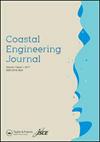波浪和海流作用下潮间带泥滩剖面演变的数值模拟
IF 1.9
3区 工程技术
Q3 ENGINEERING, CIVIL
引用次数: 0
摘要
利用现有的野外数据和扩展到允许砂和泥混合的跨岸数值模型CSHORE,研究了潮间带泥滩的侵蚀和增生剖面变化。对静水岸线和冲浪带的半日移进行了数值解析,以预测在约0.2 m高的破浪引起的小滨(底流)和滨流影响下的净跨岸和滨岸输沙率。通过使用等效岸线长度近似岸线输沙梯度,包括岸线输沙损失或增加。校准后的CSHORE重现了在206(195)天的侵蚀(增积)间隔内,在950米的跨海岸距离上测量到的约0.1米(0.1米)的侵蚀(增积)剖面变化。泥滩剖面的变化同样受到泥质特征、半日潮幅、波浪高度、周期和方向的影响。此外,岸线水位梯度和风应力对岸线流输沙也有影响。这项研究显示了在以往的数值模拟中可能被排除在外的冲浪带沉积物输运的重要性。本文章由计算机程序翻译,如有差异,请以英文原文为准。
Numerical modeling of intertidal mudflat profile evolution under waves and currents
ABSTRACT The erosional and accretional profile changes of an intertidal mudflat are examined using available field data and the cross-shore numerical model CSHORE that is extended to allow for a mixture of sand and mud. The semidiurnal migration of the still water shoreline and surf zone is resolved numerically to predict the net cross-shore and longshore sediment transport rates influenced by the small cross-shore (undertow) and longshore currents induced by breaking waves of about 0.2 m height. Alongshore sediment loss or gain is included by approximating the alongshore sediment transport gradient using an equivalent alongshore length. The calibrated CSHORE reproduces the measured erosional (accretional) profile change of about 0.1 m (0.1 m) over a cross-shore distance of 950 m during the erosional (accretional) interval of 206 (195) days. The mudflat profile changes are equally affected by mud characteristics, the semidiurnal tide amplitude, and the wave height, period, and direction. In addition, the alongshore water level gradient and wind stress influence longshore current and sediment transport. This study shows the importance of sediment transport in the surf zone that may have been excluded in previous numerical modeling.
求助全文
通过发布文献求助,成功后即可免费获取论文全文。
去求助
来源期刊

Coastal Engineering Journal
工程技术-工程:大洋
CiteScore
4.60
自引率
8.30%
发文量
0
审稿时长
7.5 months
期刊介绍:
Coastal Engineering Journal is a peer-reviewed medium for the publication of research achievements and engineering practices in the fields of coastal, harbor and offshore engineering. The CEJ editors welcome original papers and comprehensive reviews on waves and currents, sediment motion and morphodynamics, as well as on structures and facilities. Reports on conceptual developments and predictive methods of environmental processes are also published. Topics also include hard and soft technologies related to coastal zone development, shore protection, and prevention or mitigation of coastal disasters. The journal is intended to cover not only fundamental studies on analytical models, numerical computation and laboratory experiments, but also results of field measurements and case studies of real projects.
 求助内容:
求助内容: 应助结果提醒方式:
应助结果提醒方式:


